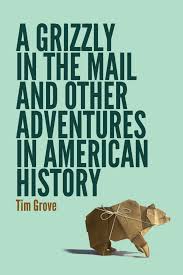A Grizzly in the Mail and Other Adventures in American History
- By Tim Grove
- University of Nebraska Press
- 256 pp.
- Reviewed by James Rada Jr.
- September 1, 2014
A Smithsonian educator discusses the problems of presenting the past to the public.

A Grizzly in the Mail and other Adventures in American History was far from what I expected. The first half of the title certainly grabbed my attention, leaving me curious about what I would find inside the book. The second half made me think this would be a book of unusual history stories. Something I love, by the way.
While there is a great deal of history in this book, it is primarily a memoir of Grove’s career. He has developed programs and exhibits for a number of notable museums, including the Smithsonian’s National Air and Space Museum and National Museum of American History.
As I started reading the book, I quickly realized it wasn’t going to be what I hoped. I was disappointed, but then something happened: I stopped worrying about my expectations and started becoming interested in how history is interpreted. I had a chance to get inside the head of someone who shapes the way that millions of people see history.
I’ve always been bothered when I see historical actions judged by today’s social mores or facts that are known today but weren’t known at the time the decision had to be made many years ago. Grove’s adventures in history illustrate the struggles museum curators have with this as they put together programming and exhibits.
The book follows his career path, stopping to explore how interesting exhibits or programs came to be. Using these programs and exhibits as anchor points, Grove then explores the history associated with them and also public reaction to the exhibits.
In one chapter, Grove talks about the 1994 decision to re-enact a slave auction at Colonial Williamsburg in Virginia. The intention was to “provoke thought about a brutal aspect of American slavery,” according to Grove, who at the time was an intern at the popular historical site. It was quickly met with protests to the point that shortly before the auction was scheduled to begin, there was still discussion as to whether to hold it. The event did proceed, and Grove deems it a success. He notes, though, that history needed to be altered somewhat to make the re-enactment provocative while still being acceptable to modern audiences.
“Ultimately decency could not allow the event to show in vivid detail the depth of inhumanity at a slave auction, but Williamsburg’s willingness to stand firm and attempt to spark discussion about America’s past can only be admired,” Grove writes. Later in the book, though, he is disconcertingly critical of re-enactors for making some changes to history, many of which were done because of necessity rather than appeasement, as with the Williamsburg example.
The author also talks about the problem of reconciling conflicting historical accounts, such as trying to piece together the life of Sacagawea for the Missouri Historical Society’s National Lewis and Clark Bicentennial Exhibition. Multiple Native American tribes have oral histories about her life, but there is little written historical evidence. It became a challenge to reconcile these accounts in a way that wouldn’t leave one group or another claiming historical inaccuracies.
Grove does a good job of weaving the historical background associated with the exhibits featured in the book into his narrative. Though it slows the story a bit, it couldn’t be helped. For the most part, the background was needed, particularly for any readers unfamiliar with that aspect of history. Besides, how can you have adventures in American history without American history?
At times, the book is quite humorous, as Grove recounts his experiences in trying to use a cotton gin and riding an old-time high-wheeler bicycle around the National Mall and not knowing how to dismount.
One of Grove’s strengths is that he writes from a quite varied experience. Besides the historical events already mentioned, Grove writes about the beginnings of airmail, the Star-Spangled Banner, buffalo hunting, the space shuttle, and more, tying all those aspects of history into his own experiences with exhibits or museum programs relating to the topic in question.
Grove gives a good reason for caring about history and how it is interpreted: “Why should people care about the past? Because our future depends on how well we learn its lessons. Thomas Jefferson was right; history’s power lies in the fact that it informs the future. I love history because it incites my imagination and offers endless stories of real people who faced tough challenges. But whether slaves debating the meaning of freedom, Lewis and Clark encountering unfamiliar native customs, or John Brown leading deadly protests, the stories don’t mean much unless I apply them to my own experiences and the world around me.”
[Tim Grove will appear at this year’s Fall for the Book festival, which takes place Sept. 11-18 at locations around the DC metro area.]
James Rada Jr. is an award-winning freelance writer and author living in Gettysburg, Pennsylvania. Much of his writing is about historical topics.

_1_80_115.png)